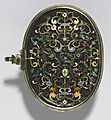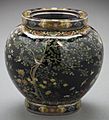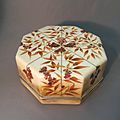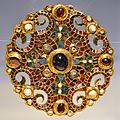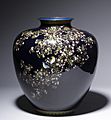Cloisonné facts for kids
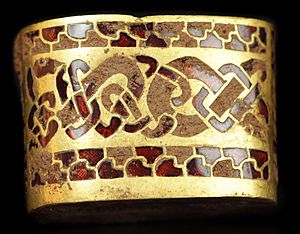
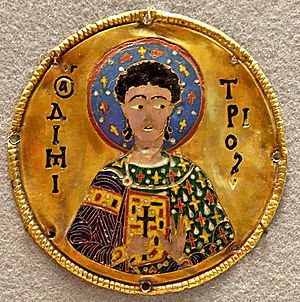
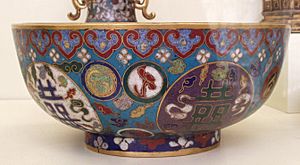
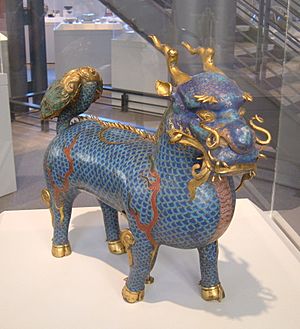
Cloisonné, a French word meaning "enclosed", is a metal-working technique. It is an ancient technique for decorating metalwork objects. The resulting objects can also be called cloisonné.
The decoration is formed by first adding compartments or cells to the metal object. This is done by soldering or sticking silver or gold wires or thin strips placed on edge. These are visible in the finished piece, separating the different compartments.
Coloured enamel is the usual filling for the cells. Cloisonné enamel objects are worked on with enamel powder made into a paste, which then is fired in a kiln. In older times inlays of cut gemstones were often used.
The technique was in ancient times mostly used for jewellery and small fittings for clothes, weapons or similar small objects. They were decorated with geometric or schematic designs, with thick cloison walls. In the Byzantine Empire a technique with thinner wires were developed. This let pictorial images to be made. It was mostly used for religious images and jewellery, and by then always using enamel. By the 14th century this enamel technique had spread to China, where it was soon used for much larger vessels such as bowls and vases. The technique is common in China to the present day. Cloisonné enamel objects using Chinese-derived styles were produced in the West from the 18th century.
The earliest surviving cloisonné pieces are rings in graves from 12th century BC Cyprus, using very thin wire.
Images for kids
-
Pectoral of Senusret II, from his daughter's grave, using shaped stones rather than enamel. Cloisonné inlays on gold of carnelian, feldspar, garnet, turquoise, lapis lazuli, 1880s BC
-
French 16th-century mirror-back, with cloisonné/plique-à-jour backed onto glass or rock crystal
-
Khalili Imperial Garniture. Made in Japan during the Meiji period, it was the largest cloisonné enamel in history at the time and was exhibited at the World's Columbian Exposition in 1893.
-
Tea caddy, silver gilt, opaque raised cloisonné enamel, House of Fabergé, Russia, before 1896
-
The Dorestad Brooch, c. 800, found in the Netherlands. Gold, pearls, with cloisonné almandine, enamel, and glass.
-
Visigothic 6th-century eagle-fibula, from Spain with garnets, amethysts, and colored glass, and some cloisons now empty.
-
Plaque with Saint Peter showing the unique transitional technique of the Holy Crown of Hungary (see text)
-
Chinese shrine for a Bodhisattva, 1736–1795. Shrine: Cloisonné enamel on copper alloy; Figure is copper with gems
-
Qing dynasty cloisonné dish
-
Matching Pair of Cloisonné Vases, c. 1800–1894, from the Oxford College Archives of Emory University
-
Kyoto Cloisonne Enamel, by Namikawa Yasuyuki (1845–1927)
-
Tokyo Cloisonne Enamel, Shōtai Shippō by Namikawa Sōsuke (c. 1900), translucent plique-a-jour enamel on silver.
-
Harley-Davidson "100th Anniversary" fuel tank "cloisonné" on a 2003 Dyna Low Rider
See also
 In Spanish: Esmalte alveolado para niños
In Spanish: Esmalte alveolado para niños




